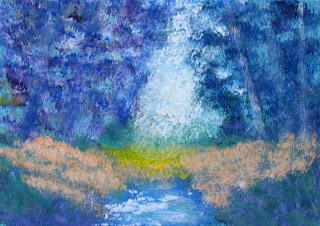
Original paintings and photographs from California artist, Atul Pande. All works copyrighted.
Monday, December 29, 2008
Forest Light

Sunday, December 7, 2008
Tagged? More like flattered!

Saturday, December 6, 2008
Practice makes.......better?

Sunny Meadow is illustrative of the "practice" aspect of my self-education. In the early days of my playing around with paint and canvas, I was completely baffled by the seemingly infinite range of greens that are possible in a landscape! After many attempts to "get is right", I ended up with Sunny Meadow. Perhaps on par with the exhilaration of riding a bike without the training wheels, I was struck by how everything seemed to click together for this piece. I am sharing it for the benefit of all those self-taught artists who despair that they will ever attain sufficient command of their materials to make anything of interest. All I can say is you MUST keep trying.
Sunday, November 30, 2008
Light and Dark

Tuesday, November 25, 2008
Blazing Sunset

Monday, November 24, 2008
Poppyfield
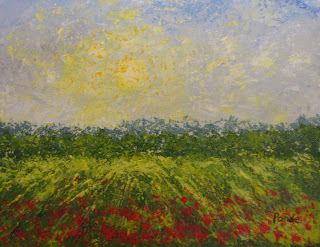
Sunday, November 23, 2008
Sunrise in Abstract
 Knives are a fun tool for acrylic painting particularly when using the wet-on-wet technique. Paints can be dragged across the canvas to create interesting mixtures that allow for optical blending that might otherwise take hours of work with a brush.
Knives are a fun tool for acrylic painting particularly when using the wet-on-wet technique. Paints can be dragged across the canvas to create interesting mixtures that allow for optical blending that might otherwise take hours of work with a brush. Sunday, November 16, 2008
Day's End

Marsh Sunset is inspired by various photographs I took of sunsets and marshes when we lived in Connecticut. The paints are applied thinly and it took several glazes to get the colors right where I was satisfied with them.
Marsh Sunset, Acrylic on Canvas Board, 16"x20", $120 (framed)
Friday, November 14, 2008
Humble Inspiration

A mental sketch of those swampy scenes has hung around in memory and was the source for Dead Woodland. There is nothing special about the technique here, although I was able to use my (only) recently refined skill in the use of the liner brush to create the tree branches.
Dead Woodland, Acrylic on canvas board, 16"x20", $100 (unframed)
Friday, October 31, 2008
Time-limited Painting

For Marshland, I set a time limit of about 20 minutes from picking up the brush to the finished painting. To be honest, I did spend many days rehearsing the painting in my mind. I deliberately chose a colorful palette so as to not to waste time picking the perfect color.
The time limit led to minimal working of the paint. This in turn produced freshness of color that would be easily lost by excessively re-working the paint.
Marshland, acrylic on board, 8" X 10", $75 (unframed)
Saturday, October 25, 2008
Tonking an abstract?
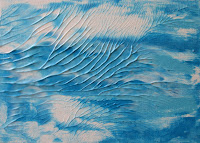 Waves
WavesWaves, Acrylic on canvas board, 5" X 7", Not for sale
Saturday, October 11, 2008
Repeating themes
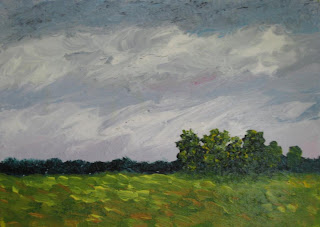
Hayfield is a small piece that was done some time ago, but really just finished recently by adding highlights to the foreground. Pieces like this have taught me that aspects of the same scene can be re-arranged in numerous ways to compose a painting. The discipline that comes from doing such a "series" of paintings has helped me overcome the beginner's notion that I must have novel inspiration for each piece!
Hayfield, Acrylic on canvas board, 5" X 7", $35 (unframed)
Thursday, October 9, 2008
Limited palette painting

Three Trees is a small piece done with just four colors (dioxazine purple, light blue permanent, chromium green and yellow ochre, plus white gesso) and one filbert brush. While doing this painting, I roughly counted the brush strokes and I am pretty sure that there were less than 50. Next time I will be aiming for less because it sems to lead to cleaner color.
Three Trees, Acrylic on canvas board, 5" X 7", $40 (unframed)
Saturday, October 4, 2008
Afternoon on the Prairie

Tuesday, September 30, 2008
Rockface

Rockface was done in two sessions. At first the underlying cooler colors (blue, violet, grey and black) were laid down in a rough manner. The idea was just to get the canvas covered. Once this was dry, the warmer (yellow, red, and orange) paints were applied thickly with different sized knives. Lightly grazing the paint-loaded knife across the previous dry layer is a perfect method to reveal unpredictable textures and shapes. While working the second layer two things happened. First, craggy shapes began to appear almost as if on their own. Second, I could feel the temptation to keep working the paint growing with each stroke! As any artist knows, the latter is the surest enemy of beautiful vibrant color. Fortunately, I was able to stop before ending up with a lot of mud on the canvas.
Rockface, Acrylic on canvas board, 18”X24”, $350 (Unframed)
Friday, September 26, 2008
Urban Jungle - Another Abstract Piece

Displays like that probably contribute to the average viewer’s belief that abstract art can be done by anyone. I can recall seeing other examples of works in museums across the US and Europe that leave one puzzled as to why the piece is on display. A simple blob of one color on top of another says little to me either about the inspiration of the artist nor their command of the medium or technique. On the other hand, great abstract art can convey the tremendous inspiration and energy of its creator without requiring any philosophical assumptions by the viewer.
I did Urban Jungle in between some of the other works. Though a small piece, it was hard work with many steps. The paints were layered and lifted with both knife and brush. The textured appearance on the upper right was achieved by swirling and lifting paint rather than by adding thick paint. The composition is based on Bob Rankin’s idea of an uneven edge ratio in an abstract painting as a method to create interest. It seems to work.
Urban Jungle, Acrylic on 140lb watercolor paper, 6”X9”, Not for sale
Tuesday, September 23, 2008
Fast and loose

Summer Scene was done in just about half an hour against a roughly sketched in composition. The only brushstrokes used in this piece are ones that either put the paint down on the paper or those that instantly led to an impression of movement. I made no attempt to smooth the paint or even out the color. Personally I think the sky is the most interesting aspect of this picture!
Summer Scene, Acrylic on 140lb watercolor paper, 9"X12", $70 (unframed)
Sunday, September 21, 2008
Time-of-day effects in a landscape

Sunset is an attempt to use the same composition as in Distant Coastline but with colors that might be more likely as the color hue and temperature changes with the waning of the day. The basic method used in Sunset is as I have previously described -- layers of gesso worked to a buttery cover for the canvas and then other colors worked into it with a knife.
Pictures like Sunset do not effectively separate the background, middle ground and foreground - except with the use of color. This can make the perspective appear a bit flat. This is less of a problem for an impressionistic work like this one but would be problematic for a more realistic style.
Sunset, Acrylic on canvas board, 8"X10" $90 (unframed)
Monday, September 15, 2008
Quick studies aren't so quick!

 Before taking up painting, I had the naive impression that doing a "quick study" meant less effort. As I have tried different techniques to get to a finished picture, it has become evident that a quick study sometimes is anything but. Getting the composition and tonal values right can often be almost as much of a challenge as finishing the final picture or a bigger version of the study. In industrial parlance, a study would be the prototype from which the final (or 'production') version is derived.
Before taking up painting, I had the naive impression that doing a "quick study" meant less effort. As I have tried different techniques to get to a finished picture, it has become evident that a quick study sometimes is anything but. Getting the composition and tonal values right can often be almost as much of a challenge as finishing the final picture or a bigger version of the study. In industrial parlance, a study would be the prototype from which the final (or 'production') version is derived.Tuesday, September 9, 2008
Abstract flower

Sunday, September 7, 2008
Backlit flower

Blue Flower, Acrylic on canvas board, 18"X24", (Not for sale)
Wednesday, September 3, 2008
Minimal brushstrokes painting style

In Reflections, I have used a rather common scene of trees reflected in the water to demonstrate a minimal brushstrokes approach. The palette is restricted (ultramarine blue, sap green, cadmium yellow and titanium white) and I used the biggest brush I could force myself to pick! After all, this is a small canvas and the temptation was to reach for a small brush. The bigger brush allowed for the canvas to be covered quickly and with the self-imposed limit on brushstrokes, there was no choice but to leave the paint alone after it was down on the canvas.
Reflections, Acrylic on canvas board, 5”X7” (Not for sale)
Sunday, August 31, 2008
Fascination with farmland

Saturday, August 30, 2008
Seascape in impasto

For Distant Coastline, I covered the canvas with a thin layer of acrylic gesso and let it dry. Then I used a painting knife to roughly spread thick gobs of white gesso all over the canvas starting from the top. The sky and the water were painted starting from the top and the bottom, respectively, using ultramarine blue closest to the top and bottom. Cerulean blue was used closer to the horizon. With more gesso on the painting knife I spread a thin layer from the top towards the horizon. I repreated the same process from the bottom up. By varying the pressure of the knife, I was able to create the color-mixing and textures that I wanted.
By now there was enough pain on the canvas to slow down the drying giving me enough time to work the coastline. The coastline was built up with layers of dioxazine purple, burnt umber and ivory black. Very thin lines of paint along the knife edge were worked into the creamy layers of gesso. Once the outline of the coast was set, more paint was added to create depth. Finally, with a thin bead of white gesso on the knife, I cleaned out the bottom edge of the coast. This also allowed some of the land colors to be drawn into the water creating reflections.
Wednesday, August 27, 2008
Simple watercolor
 Watercolor is probably not the easiest medium for self-taught artists. From figuring out the choice of paper weight to the amount of water to use were aspects of using watercolor paints that I learned through experimentation. Having started with acrylics first, it was easy to assume some of the same attributes would carry over. The task proved much trickier as I came to realize what every half-decent watercolorist knows! Watercolor paint can only be worked over so much before the freshness of the color is lost leading to drab, muddy pictures.
Watercolor is probably not the easiest medium for self-taught artists. From figuring out the choice of paper weight to the amount of water to use were aspects of using watercolor paints that I learned through experimentation. Having started with acrylics first, it was easy to assume some of the same attributes would carry over. The task proved much trickier as I came to realize what every half-decent watercolorist knows! Watercolor paint can only be worked over so much before the freshness of the color is lost leading to drab, muddy pictures. Sunday, August 24, 2008
Painting for fun!
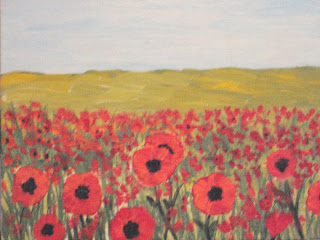
Philosophy aside, sometimes painting is just for fun and not a response to some inner angst that must drive creativity. Red Flowers is one such fun painting. It took only a few minutes to do. Perhaps to some it will appear trivial or reminiscent of grade school 'art'. But this little painting makes me smile every time I look at it. Tell me what you think.
Thursday, August 21, 2008
What to paint?

Sunny Fields reminds me of an American midwest scene, such as you might drive by on the freeway without paying attention. Even the greatest hurry is insufficient sometimes to allow one to ignore certain scenes that have just the right combination of elements -- perhaps even something as trivial as an angled sliver of light hitting the grass or the treetops in a way that makes an ordinary setting memorable. The painter is at liberty to interpret such moments in a way that perhaps a photographer might not.
Sunday, August 17, 2008
Brushless abstract

Summer Flowers, Acrylic on 140lb watercolor paper, 9"X6", $50 (unframed)
Tuesday, August 12, 2008
Color and form in landscape
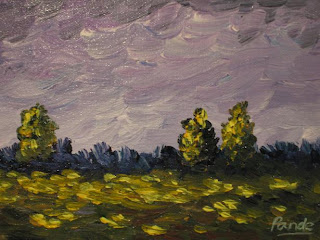
Love of the landscape

Sunday, August 10, 2008
Second abstract in acrylic

The ice has been broken! After my first acrylic abstract, I discovered the true freedom that comes from relinquishing control to the medium. Fluid acrylics and a few simple techniques can produce wonders that no amount of slaving over a canvas will. For this piece in particular, I was worried about being able to create enough movement and excitement with just three colors. As it turned out, the acrylics moved in fascinating ways that was a pleasure to watch. I hope you enjoy it too.
Nature's Force, Acrylic on canvas board, 18"X24", $150 (unframed)
First abstract in acrylic

